Tuesday, March 11, 2014
Monday, October 1, 2012
Hiyayakko (Chilled Tofu with Soy and Ginger)
Hiyayakko (cold silken tofu with ginger & scallions)
Recipe by Caroline Phelps

This is a very popular and classic Japanese side dish
that is very simple to make as there is no cooking involved.
It's one I personally often crave because it's so light,
healthy and clean in flavors. The key is finding
good silken tofu; Do not make this recipe if you
cannot find any.
(serves 2-3 people)
Ingredients
- 1 package (12 oz) silken tofu
- 1 scallion, finely chopped
- 1 small thumb size ginger, peeled and grated
- bonito flakes (katsuobushi)
- light soy sauce
Cooking Directions
Take tofu out of the package and drain.
Cut the tofu in 1/2 or 1/3 (depending on the serving size you wish to have). Plate the tofu and add some scallions, a little freshly grated ginger and sprinkle some bonito flakes.
Pour a little soy (too much will over power the delicate flavor of the tofu) and serve.
Spicy Garlic Fried Rice
I love these Japanese fried rice mix packages! They are so good to have around the house for days when I don't feel like spending more than 20 minutes in the kitchen. If you've never tried them, I urge you to go to your closest Japanese grocer and try all the different flavors, they are delicious! One flavor I often use is garlic. It's mild but still gives the fried rice a good, almost smoky base. To that I add a few more ingredients, serve it and watch my husband deliriously happy devour his bowl of fried rice. This recipe is his favorite because it encompasses two flavors he adores: fish sauce and tobanjan paste. The result is spicy, salty and smoky garlic fried rice. Yum!
Can't find Japanese fried rice mix packages? Look at the end of this recipe for 3 basic, tasty fried rice recipes.
- 2 garlic cloves, finely chopped
- 1/2 medium size onion, finely chopped
- 2 celery stalks, finely chopped
- 1 tsp tobanjan
- 1 1/2 tsp fish sauce
- garlic fried rice mix
- about 2 cup pre-cooked rice (you can use any type of rice for this)
- 2 tbps oil
- 2 large eggs
- 3/4 cup, finely chopped mushrooms
- salt and pepper to taste
Directions:
In a medium/large size pan, add oil garlic, onions and celery. Cook for 3 minutes. Add mushrooms and cook for 2 minutes. Add rice and slowly break it down with a wooden spatula, and stir for 2 minutes. Add fish sauce, tobanjan and fried rice mix, and stir well for another minute.
Lower the heat, push the fried to one side of the pan and break the 2 eggs on the other. Whisk the eggs with the spatula (like you would if you were making scrambled eggs) and once the eggs are almost cooked, slowly incorporate into the fried rice. Season with salt and pepper and serve.
If you don't have pre-packaged fried rice mix, you can try this simple vegetable fried rice, Japanese fried rice or garlic fried rice I also created. They're all very similar but with a slight change of ingredients.
Friday, September 21, 2012
Shishito peppers stuffed with tsukune (ground chicken)
Shishito Tsukune
Recipe by Caroline Phelps
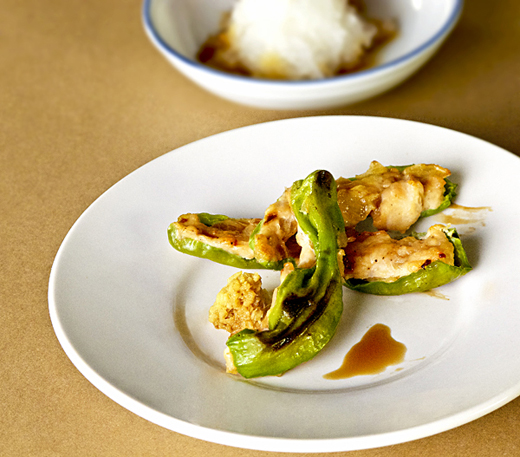
I discovered this yummy dish at Yakitori Totto, one of my top 3 Japanese spots (Izakaya) in the city. Skewered and grilled on a brazier, and served with a raw
quail egg that's broken and used as a dipping sauce, it's a beautiful and fun
dish to eat. Since I don't own a grill I've instead used an oven and skipped the
quail egg, though I highly recommend you try it if you come across some.
Shishito peppers can be spicy with the seeds attached but aren't when you
remove them. They're sweet and pair well with the teriyaki like flavor of
the chicken meatballs.
(makes a large plate, enough to serve 4-6 people)
Ingredients
- 2 tbsps vegetable or canola oil
- 1/2 lb ground chicken
- 1/2 medium onion, finely chopped
- 1/2 thumb size ginger, grated
- 1 garlic clove, finely chopped
- 1 1/2 tbsp sake
- 1/2 tbsp soy sauce
- 1/2 tsp kosher salt (or 1/4 tsp table salt)
- Shishito peppers (about 20-25), cut in half, seeded and membranes removed
- For the Dipping/Brushing Sauce:
- 1 tbsp sake
- 3 tbsp mirin
- 3 tbsp soy sauce
- 1 tsp granulated sugar
Cooking Directions
Preheat oven to 350 degrees.
In a pan over medium/high heat, add oil, ginger, garlic and onions. Cook until onions are transparent (about 3 minutes). Transfer mixture into a bowl and let cool (put in fridge or freezer to speed up the process.) When the mixture is room temperature, add ground chicken, sake, soy and salt . Mix well with your fingers (not for too long.)
With a knife, spread a generous amount of the mixture on each piece of shishito pepper. Discard the rest or save for later (if I have any left, I'll usually make mini burger patties or eat it on top of Japanese rice with ichimi and soy sauce). Lay each piece on a tray covered with aluminum foil (or parchment paper). Bake for 15-17 minutes, until chicken has cooked through. While shisihitos are cooking, make your sauce.
Mix all the ingredients and microwave for 20-30 (to melt the sugar). Take shishitos out of the oven and with a basting brush, dab the sauce over each piece. Put leftover sauce in a small bowl and serve next to shishito tsukune (people can use is as a dip).
10 Japanese Izakaya Dishes for Beginners
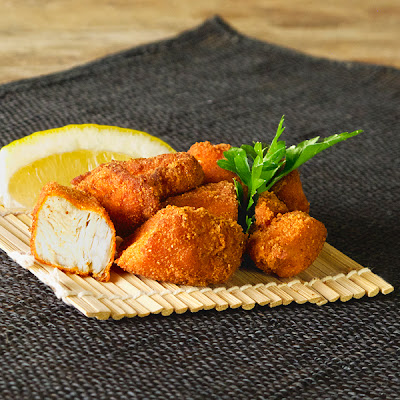 |
| Japanese fried chicken (tori no kara age) |
Japanese food can be intimidating if all you know about the cuisine is sushi
and miso soup. Take a trip there and you'lI quickly see that more Americans
eat sushi on a regular basis than Japanese people. True traditional Japanese
food is so much more than that and unlike popular belief, not everyone over
there likes raw fish (in fact, I have 3 cousins in Japan who are so repulsed by
the thought of raw fish, they refuse to try it even just once). A good way to
discover the many different facets of Japanese cuisine is to visit an Izakaya
(Japanese drinking establishment where they serve a myriad of appetizer size
dishes) and try as many different plates as you can. This is a great way to get
your feet wet into one of the world's most colorful and complex cuisines. 15
years ago you would've had to have been in Japan to find Izakayas but thing
have changed; nowadays Izakayas are becoming more popular in the western
world and can be found in big cities like New York, Chicago, L.A, Toronto and
Montreal.
Izakaya menus
are great because they're filled with pictures which makes it easy to
understand
and see what you're about to order.
 |
| A typical Izakaya menu looks like this |
But this can still be a challenge if you're
not familiar with this
type of food and can quickly get confusing as Izakaya menus are large and incredibly varied,
offering everything from a simple tomato
salad, to
oddities like fermented firefly squid.
I love
the fact that more and more people are interested in Japanese food and
wanted to
help by giving a list of 10 basic can't go wrong dishes to order for
beginners.
Nothing too out there in texture or taste, popular dishes I've seen
groups of
friends and English teachers ordering frequently in Tokyo and all over
Japan.
This list is for all of you out there (including the lovely couple at Sake bar
Hagi who
so eagerly wanted to expand their knowledge of Japanese food and
were
brave enough to ask for our help) who want to discover what the world has
to offer,
who want to become more adventurous and add new notches to your
culinary
belt.
 |
| Okonomkiyaki |
1 -
Okonomiyaki
(also known as Japanese Pizza) meaning "what you like" or "what you want", this is a classic savory pancake made with flour and eggs, and mixed with veggies such as cabbage, onions, carrots, meats like pork, bacon, or seafood like squid or shrimp. It's topped with bonito flakes, mayonnaise and tonkatsu sauce (sweet sauce, similar to worcestershire without the smokiness).
 |
| Berkshire Sausages |
2 - Berkshire Sausages
Yes sausages! What makes these sausages special is the casing;
thicker to bite into, the sausage pops into your mouth and lets all the juices out. Served with a little Japanese hot mustard, these sausages are available regular or spicy. Once again the Japanese have taken something that wasn't theirs and made it better.
So simple; It's spaghetti made with ketchup, tabasco and butter, and it tastes GOOD! This easy pasta dish is topped with sliced onions, green peppers and ham (or sausage).
 |
| Yakisoba |
4 -
Yakisoba
Similar to ramen noodles but stir fried, yakisoba comes with pork, cabbage, onions and carrots. The yakisoba sauce is mainly made of soy, rice wine vinegar and a dash of worcestershire. It's topped with seaweed powder and pickled ginger.
 |
| Cream Croquettes |
5 - Cream Croquettes (korokke)
Deep fried balls of creamy potatoes and white sauce mixed with chopped meat, seafood or vegetables, these are incredible! The
outside is made of crispy deep fried breadcrumbs, while the inside
oozes out fluffy creamy deliciousness as you break your chopsticks
into it. Croquettes are often served with tonkatsu sauce and shredded cabbage.
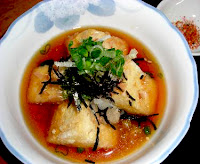 |
| Agedashi Tofu |
6 -
Agedashi Tofu
Deep fried silken tofu cubes (dusted with potato starch or cornstarch) served in a hot tentsuyu broth (mirin, soy sauce and dashi) which tastes a little sweet but more on the savory side. It's topped with grated daikon (radish), bonito flakes and scallions. One my absolute favorites.
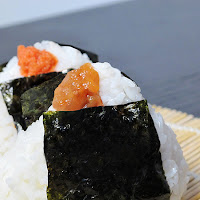 |
| Onigiri |
Triangular or round shaped rice balls with the middle filled with salmon, pickled plum, kombu, mentaiko (spicy cod roe), or okaka (bonito flakes with soy sauce), wrapped with nori (dried seaweed sheet).
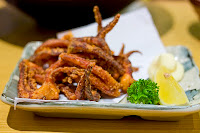 |
| Ika Geso Age |
8 - Deep Fried Squid (Ika geso age)
Simple and delicious; deep fried squid served with lemon wedges. Japanese people use potato starch or cornstarch to fry the squid, giving it a much lighter texture than the typical deep fried squid you'd find in a pub or greek restaurant.
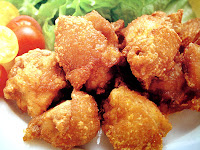 |
| Tori no kara age |
This is Japan's version of fried chicken. Prepared the same way as deep fried squid and also served with lemon wedges and fresh grated daikon, you'll want some more.
 |
| Tsukune |
I know I said I'd give 10 recommendations but I had to add one last that should never be skipped!
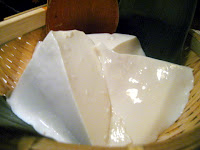 |
| Homemade Tofu |
11 - Tofu (NOT TO BE MISSED ONLY IF IT'S HOME
MADE)
I've always said "you don't know what real tofu tastes like until you've had fresh home made one". This statement still holds true as I've converted many of my friends into tofu lovers after taking them to the best tofu spots in NYC. Believe me, it's worth it, fresh home made tofu melts in your mouth and almost tastes like soy milk.
Chawanmushi (Japanese egg custard)
Chawan Mushi
Recipe by Caroline Phelps
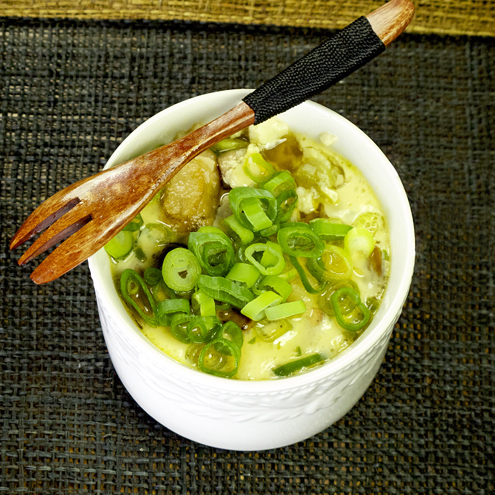
This light and delicate egg custard is a wonderful appetizer to
prepare if you're looking to wow your partner or dinner guests.
It's both beautiful and fun to eat, is extremely simple and easy
to make, and require few ingredients. This Japanese dish is
often served in omakase meals and in traditional Japanese restaurants.
The flavors are mild, eggy and earthy, with a texture very similar to silken tofu.
- 1 1/2 cup low sodium chicken or beef broth (room temperature)
- 4 large eggs
- 1 tbsp extra virgin olive oil
- 2 cups chopped mushrooms
- 3 scallions, finely chopped
- Sauce:
- 4 tbsp low sodium chicken or beef broth
- 1 1/2 tbsp light soy sauce
- 1 tsp sesame oil
- 1 tbsp rice wine vinegar
Cooking Directions:
Bring the water in your steamer to boil, cover and lower the heat to simmer.
Whisk the eggs and add broth. In 4 small separate bowls, equally divide the mushrooms and pour the egg stock on top. Add a few scallions in each cup and briefly stir. Put the cups in the steamer, cover and steam for 12-14 minutes.
Meanwhile mix all the ingredients of the sauce together and set aside. When the custard cups are ready, take them out of the steamer, pour a little sauce on top and garnish with scallions.
Agedashi Tofu
Agedashi Tofu (Deep-Fried Tofu with Bonito Soy Broth)
Recipe by Caroline Phelps
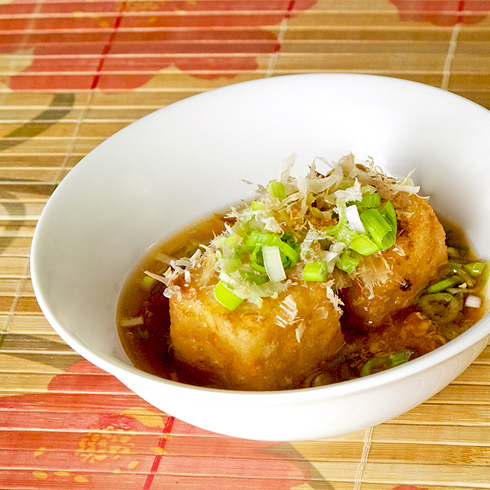
When prepared properly, agedashi tofu is one of the best things you can have.
The outside is lightly fried while the the tofu inside almost melts in your
mouth. The warm broth added to the dish is full of umami and a little sweet,
while the grated ginger on top brings freshness, rounding up all the flavors
beautifully. This recipe is taken from Harumi Kurihara's Harumi's Japanese cooking.
(Serves 4)
Ingredients
- 2 - 12.3 oz boxes soft silken tofu
- potato starch or cornstarch for dusting the tofu pieces
- oil - enough to deep-fry the tofu
- 1 cup dashi stock or fish stock
- 2 tbsp mirin
- 2 tbsp soy sauce
- a little superfine sugar (about 1/2 tsp)
- a little salt (1/4 tsp)
- grated daikon
- grated ginger to taste
- shiso leaves, chopped into thin strips or a mix of fresh basil and mint (optional)
- myoga (optional) minced
- green onion or chives, minced
Cooking Directions
Drain the tofu and then wrap it in paper towels and place in a strainer for 30 minutes to remove excess moisture. Cut the tofu into four pieces, dry again with paper towels, the coat with the potato starch.
Heat the oil to a suitable temperature for deep-frying (around 340 degrees). Carefully put the tofu pieces in to fry and when they turn golden, remove and drain on paper towels to remove excess oil. In a small pan heat up the dashi stock, mirin, soy sauce, sugar and salt. Bring to the boil, ensuring that the sugar has dissolved.
Divide the tofu among four bowls. Pour a little of the hot sauce into each bowl and garnish with the grated daikon, a dab of grated ginger, shiso, myoga, and green onion to taste.
Subscribe to:
Posts (Atom)








